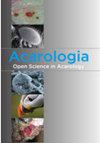洛里亚(鞘翅目,蝶科):一个谜属的进化可塑性
IF 0.9
3区 农林科学
Q3 ENTOMOLOGY
引用次数: 2
摘要
对Lorryia Oudemans属1925年的解释及其各自的标准进行了综述。在考虑了奥德曼的详细描述和之前无法获得的板块后,这一独特的模式标本(丢失?)并不被认为是异常的,而是揭示了与其他Tydeoide目一致的进化途径(异趾,眼睑毛额减少)。经过讨论,该属在其原始状态下重新建立,并保持单特异性(L.superba)。Brachydeus Thor属,1931年(约200种)与Lorryia截然不同,不值得任何同义词。本文章由计算机程序翻译,如有差异,请以英文原文为准。
Lorryia (Acariformes, Tydeidae): The evolutionary plasticity of an enigmatic genus
Interpretations of the genus Lorryia Oudemans, 1925 are reviewed together with their respective criteria. After consideration of Oudemans' detailed description and previously unavailable plates, the unique type specimen (lost ?) is not considered abnormal but rather reveals evolutionary pathways (heterobidactyly, reduction of the palp chaetotaxy) consistent with other Tydeoidea. After discussion, the genus is re-established in its pristine state and remains monospecific (L. superba). The genus Brachytydeus Thor, 1931 (ca 200 species) is quite distinct from Lorryia and does not deserve any synonymisation.
求助全文
通过发布文献求助,成功后即可免费获取论文全文。
去求助
来源期刊

Acarologia
ENTOMOLOGY-
CiteScore
2.00
自引率
18.20%
发文量
81
期刊介绍:
Acarologia is a free open-access journal. Please help us by submitting manuscripts in accordance with following instructions.
All manuscripts which do not conform to the instructions will be returned to authors without the benefit of review.
Acarologia publishes the results of original research on all aspects of Acarology.
The journal policy is that taxonomic descriptions should include several species within a same genus/family, when possible.
The editors reserve the right to refuse manuscripts when authors intentionally divide individual species descriptions of the same genus/family into distinct publications.
Single species descriptions should be clearly justified based on their scientific interest.
 求助内容:
求助内容: 应助结果提醒方式:
应助结果提醒方式:


